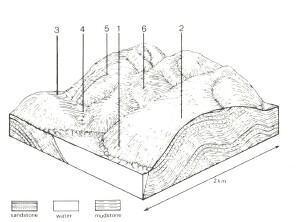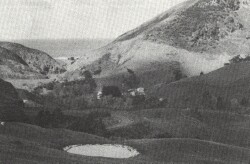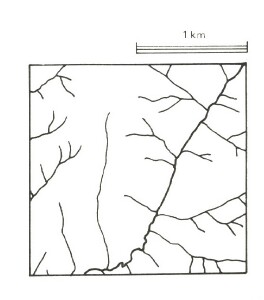Lorne Land System
Download the pdf version of this document: Lorne Land System (PDF - 189 KB)
To view the information, PDF requires the use of a PDF reader. This can be installed for free from the Adobe website (external link).
| From Cinema Point to Moonlight Head, much of the coastline consists of steep slopes, coastal cliffs and rocky shore platforms. These coastal margins of the Range have a milder maritime climate than those areas further inland, and receive a lower rainfall. Inland from the coast the topography consists of steeply dissected spurs and ridges with cliffs and waterfalls. The steepest slopes have shallow stony soils with areas of rock outcrop. Most slopes, however, have moderately deep duplex soils. On inland slopes with a southerly aspect, no strong profile differentiation has occurred and profiles are gradational. Tall open forests, with understorey species such as Bedfordia salicina, Olearia spp. and Pomaderis spp., occupy these sites. On the duplex soils the trees are lower with a more open understorey. Large tracts of this land system have been cleared and dairy farming is a major land use. The steep slopes and deep valleys create severe management problems. The coastal areas between Cinema Point and Apollo Bay have been popular for residential development. Landslips are very common and sheet erosion has been widespread. |  |
 Siting of roads, fences and access tracks in this rugged terrain creates many problems, and management is difficult |  |
Area: 220 km2 | Component and its proportion of land system | |||||
1 7% | 2 8% | 3 35% | 4 5% | 5 35% | 6 10% | |
| CLIMATE Rainfall, mm | Annual: 850 – 1,200, lowest January (45), highest August (120) | |||||
| Temperature, 0oC | Annual: 13, lowest July (9), highest February (17) | |||||
Temperature: less than 10oC (av.) July | ||||||
Precipitation: less than potential evapotranspiration mid November – mid March | ||||||
| GEOLOGY Age, lithology | Lower Cretaceous feldspathic sandstone and mudstone | |||||
| TOPOGRAPHY Landscape | Deeply dissected hills of the Otway Range | |||||
| Elevation, m | 0 – 400 | |||||
| Local relief, m | 150 | |||||
| Drainage pattern | Dendritic with some radial areas | |||||
| Drainage density, km/km2 | 4.0 | |||||
| Land form | Coastal cliff | Hill | ||||
| Land form element | Steep lower slope | Upper gentler slope | North- and west-facing slopes, upper slope | Lower slop, drainage line | South- and east-facing slopes | Steepest slope |
Slope (and range), % | 60 (30-75) | 30 (15-45) | 45 (5-55) | 20 (1-35) | 45 (5-65) | 60 (20-70) |
Slope shape | Linear | Convex | Linear | Concave | Linear | Linear |
NATIVE VEGETATION Structure | Open scrub | Woodland | Open forest | Tall open forest | Tall open forest | Woodland |
Dominant species | Casuarina stricta, Cassinia aculeata, E. obliqua, Alyxia buxifolia, Leucopogon parviflorus | E. obliqua, E. globulus, E. radiata | E. obliqua, E. sideroxylon, E. radiata, E. cypellocarpa, E. globulus | E. ovata, E. globulus, E. cypellocarpa, Acacia melanoxylon | E. cypellocarpa, E. globulus, E. obliqua, E. ovata | E. radiata, E. sideroxylon, E. cypellocarpa occasionally E. viminalis, E. globulus |
| SOIL Parent material | Colluvium | In-situ weathered rock | In-situ weathered rock | Alluvium | In-situ weathered rock | Colluvium |
Description | Stony brown gradational soils | Brown duplex soils | Brown duplex soils | Brown gradational soils, weak structure | Brown gradational soils | Stony brown gradational soils |
Surface texture | Fine sandy loam | Fine sandy clay loam | Fine sandy clay loam | Silty loam | Fine sandy clay loam | Fine sandy loam |
Permeability | Very high | Moderate | Moderate | High | High | Very high |
Depth, m | 0.3 | 0.9 | 0.9 | >2 | 0.9 | 0.5 |
| LAND USE | Uncleared areas: Hardwood forestry for sawlogs, posts and poles; softwood plantations; nature conservation; active and passive recreation; landscape conservation; water supply. Minor cleared areas: Dairy farming and beef cattle grazing on mainly unimproved pastures; residential. | |||||
| SOIL DETERIORATION HAZARD Critical land features, processes, forms | Native vegetation is sensitive to salt pruning and disturbance. Dispersible soils on steep slopes are prone to sheet erosion. Marine under-cutting and saturation of soils lead to landslips. | Native vegetation is sensitive to disturbance and to salt pruning. Dispersible soils on moderate slopes are prone to sheet erosion. Periodic saturation of dispersible clay subsoils leads to landslips and slumping of road batters. | Dry aspect, steep slopes and weakly structured surfaces lead to sheet erosion. Clay subsoils on steep slopes subject to periodic saturation are prone to landslips. | Weakly structured soils receiving run-off are prone to scour gullying, siltation, flooding, and compaction of surface structure. | Steep slopes and weakly structured surfaces lead to sheet erosion. Clay subsoils on steep slopes subject to periodic saturation are prone to landslips. | Stony shallow soils of weak structure, and low water-holding capacity on steep slopes are prone to sheet erosion and landslides. |


